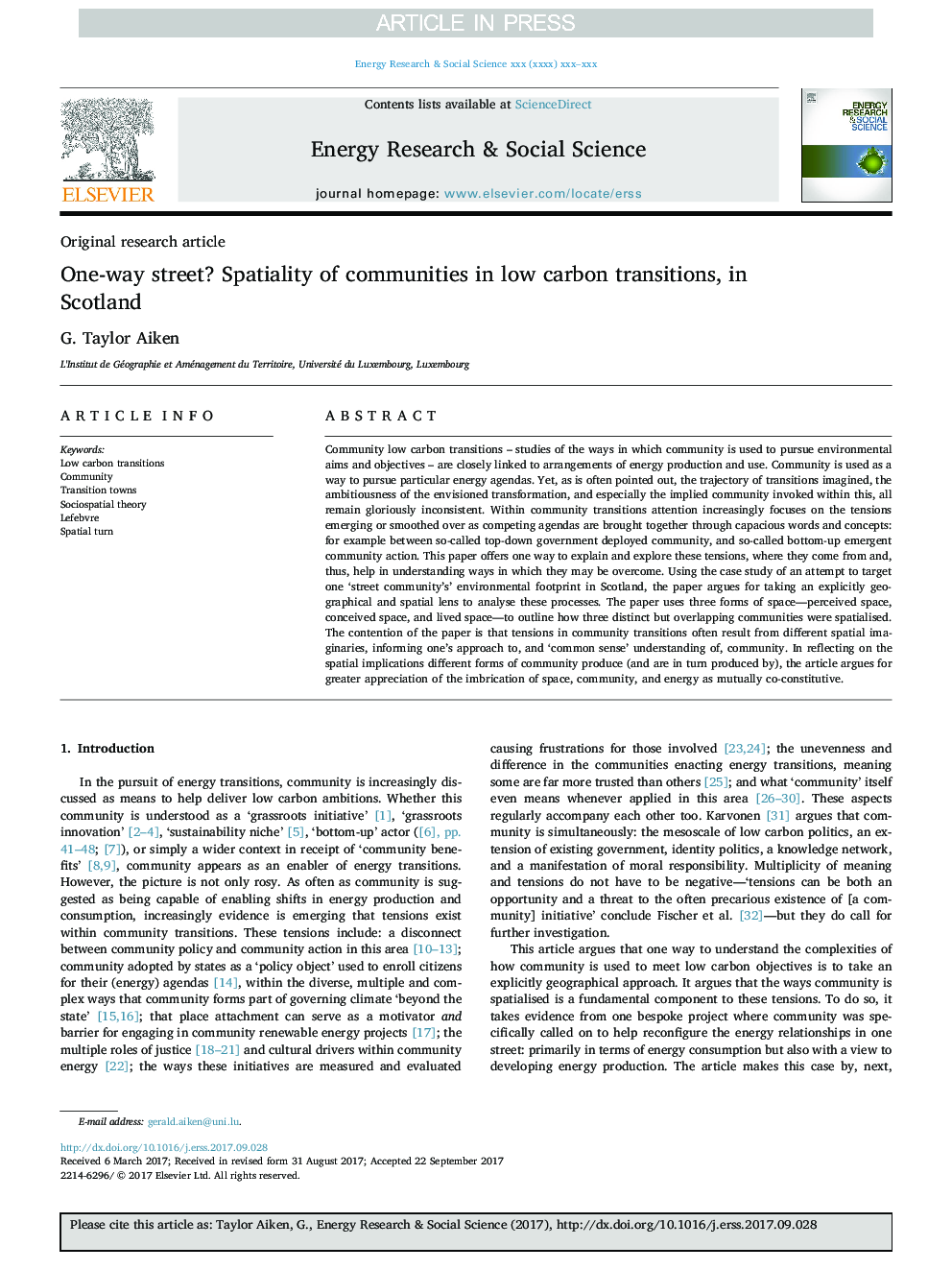| کد مقاله | کد نشریه | سال انتشار | مقاله انگلیسی | نسخه تمام متن |
|---|---|---|---|---|
| 6557720 | 1422565 | 2018 | 9 صفحه PDF | دانلود رایگان |
عنوان انگلیسی مقاله ISI
One-way street? Spatiality of communities in low carbon transitions in Scotland
ترجمه فارسی عنوان
خیابان یک طرفه؟ فضایی جوامع در انتقال کم کربن در اسکاتلند
دانلود مقاله + سفارش ترجمه
دانلود مقاله ISI انگلیسی
رایگان برای ایرانیان
کلمات کلیدی
انتقال کربن کم، جامعه شهرهای انتقالی، نظریه جامعه شناختی، لوفور، نوبه خود فضایی،
ترجمه چکیده
جامعه انتقال کربن کم کربن - مطالعات راه هایی که جامعه برای پیگیری اهداف و اهداف زیست محیطی مورد استفاده قرار می گیرد - به روش های تولید و استفاده از انرژی نزدیک است. جامعه به عنوان راهی برای دنبال کردن برنامه های خاص انرژی است. با این وجود، همانطور که اغلب اشاره شد، مسیر پیش بینی های انتقال، جاهطلبی بودن تحول پیش بینی شده، و به ویژه جامعه ی ضمنی که در آن درج شده است، همگی با شکوه ناسازگار می ماند. در جریان انتقال جامعه توجه به طور فزاینده ای بر تنش هایی که در حال ظهور یا صاف شدن هستند تمرکز می کند، زیرا برنامه های رقابتی با استفاده از کلمات و مفاهیم وسیع، به هم پیوسته اند. به عنوان مثال، جامعه بین المللی به اصطلاح "بالا به پایین" و به اصطلاح "فعالیت پایین" این مقاله یک راه برای توضیح و کشف این تنش ها، جایی که از آنها آمده است و به این ترتیب کمک می کند تا درک روش هایی را که ممکن است بر آنها غلبه کند، ارائه می دهد. با استفاده از مطالعه موردی در تلاش برای هدف قرار دادن یک محدوده زیست محیطی جامعه خیابانی در اسکاتلند، این مقاله استدلال می کند که برای لنز به صراحت جغرافیایی و فضایی برای تحلیل این فرآیندها استفاده می شود. این مقاله از سه شکل فضای درک شده فضایی، فضای درک شده و فضای زندگی استفاده می کند تا مشخص شود که چگونه سه جوامع متمایز اما با هم تداخل دارند فضایی است. مطرح شدن این مقاله این است که تنش در انتقال جامعه اغلب ناشی از تصورات فضایی مختلف، اطلاع رسانی به رویکرد خود و درک عمومی از جامعه است. در تفکر فضایی، اشکال مختلف تولید جامعه (و به نوبه خود توسط آن تولید می شود)، این مقاله برای ارزیابی بیشتر فضایی، جامعه و انرژی به عنوان متقابلا سازنده است.
موضوعات مرتبط
مهندسی و علوم پایه
مهندسی انرژی
انرژی (عمومی)
چکیده انگلیسی
Community low carbon transitions - studies of the ways in which community is used to pursue environmental aims and objectives - are closely linked to arrangements of energy production and use. Community is used as a way to pursue particular energy agendas. Yet, as is often pointed out, the trajectory of transitions imagined, the ambitiousness of the envisioned transformation, and especially the implied community invoked within this, all remain gloriously inconsistent. Within community transitions attention increasingly focuses on the tensions emerging or smoothed over as competing agendas are brought together through capacious words and concepts: for example between so-called top-down government deployed community, and so-called bottom-up emergent community action. This paper offers one way to explain and explore these tensions, where they come from and, thus, help in understanding ways in which they may be overcome. Using the case study of an attempt to target one 'street community's' environmental footprint in Scotland, the paper argues for taking an explicitly geographical and spatial lens to analyse these processes. The paper uses three forms of space-perceived space, conceived space, and lived space-to outline how three distinct but overlapping communities were spatialised. The contention of the paper is that tensions in community transitions often result from different spatial imaginaries, informing one's approach to, and 'common sense' understanding of, community. In reflecting on the spatial implications different forms of community produce (and are in turn produced by), the article argues for greater appreciation of the imbrication of space, community, and energy as mutually co-constitutive.
ناشر
Database: Elsevier - ScienceDirect (ساینس دایرکت)
Journal: Energy Research & Social Science - Volume 36, February 2018, Pages 129-137
Journal: Energy Research & Social Science - Volume 36, February 2018, Pages 129-137
نویسندگان
G. Taylor Aiken,
